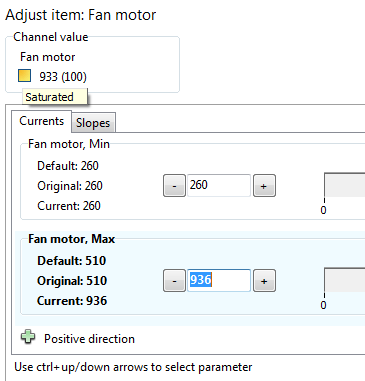
Should logging of saturation warning be kept or removed?
When the COUT regulator on an IQAN-MC2 or IQAN-XA2 is unable to deliver the commanded current, the COUT gets the status saturated.
Saturation happens when it becomes impossible to deliver the commanded current, this is when the supply voltage is too low, the coil resistance is too high, or the max current has been tuned too high.
The available supply voltage depends on the +BAT supply to the module, the internal voltage drop in the COUT, and also on the maximum pulse width, that varies with the dither frequency.
An example of when a saturation warning may be triggered is during cranking in a 24 V system, where it is usually possible to keep the IQAN system powered up. There, if a COUT is tuned close to the maximum current that can be driven through the coil during normal operation, if an output is kept on during cranking it would have the saturation warning.
The saturation status can be seen when measuring on the channel, for example in IQANdesign:

The COUT status can be seen when adjusting in IQANrun:

But the saturation warning also gets logged in the system log:

We have been getting some comments about the saturation warning, that it in some application just fills up the system log without providing much useful information for design or service.
Does anyone think that saturation warning in the log is useful?
Or that it should be removed?
11 |
||
0 |
Customer support service by UserEcho

Logging of saturation warning removed in 4.03
http://forum.iqan.se/topics/454-iqandesign-403-released/
Gustav. I am glad to see the saturation warnings go!
Also, the above description of a saturation is very good! I have asked in the past from our IQAN supplier and have not received such a good description.
Would it be possible to provide a similar description of the circumstances that cause an OVERLOAD error?
For a COUT, the overload is sort of the opposite of saturation and open load, the measured current is higher than commanded, and the current regulator in the COUT is unable to reduce it further.
One fault that would throw an overload on the COUT is to short one of the CRET pins to ground. Shorting the COUT pin to ground is what one would think of as the most typical overload scenario, but on e.g. the XA2 there is a high chance that this is reported as an open load, if the high-side driver switches off to protect itself before the software reacts.
Trying to control a COUT too far below the 100 mA limit that is specified for most COUT:s is another possible explanation for a COUT overload.
For the saturation warning, note that the warning status is not gone, it can still be seen when measuring on the channel. Only the logging of saturation in the system log is removed.